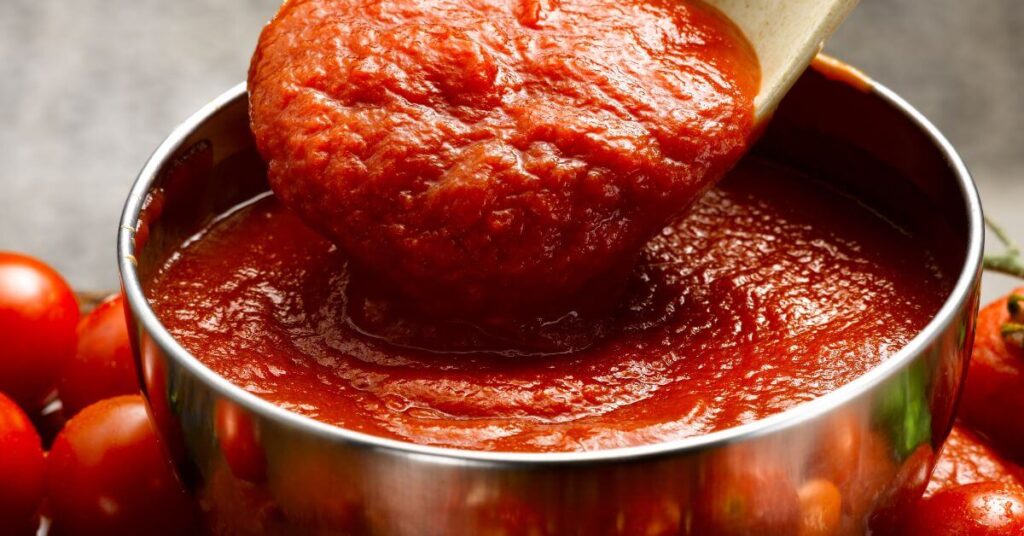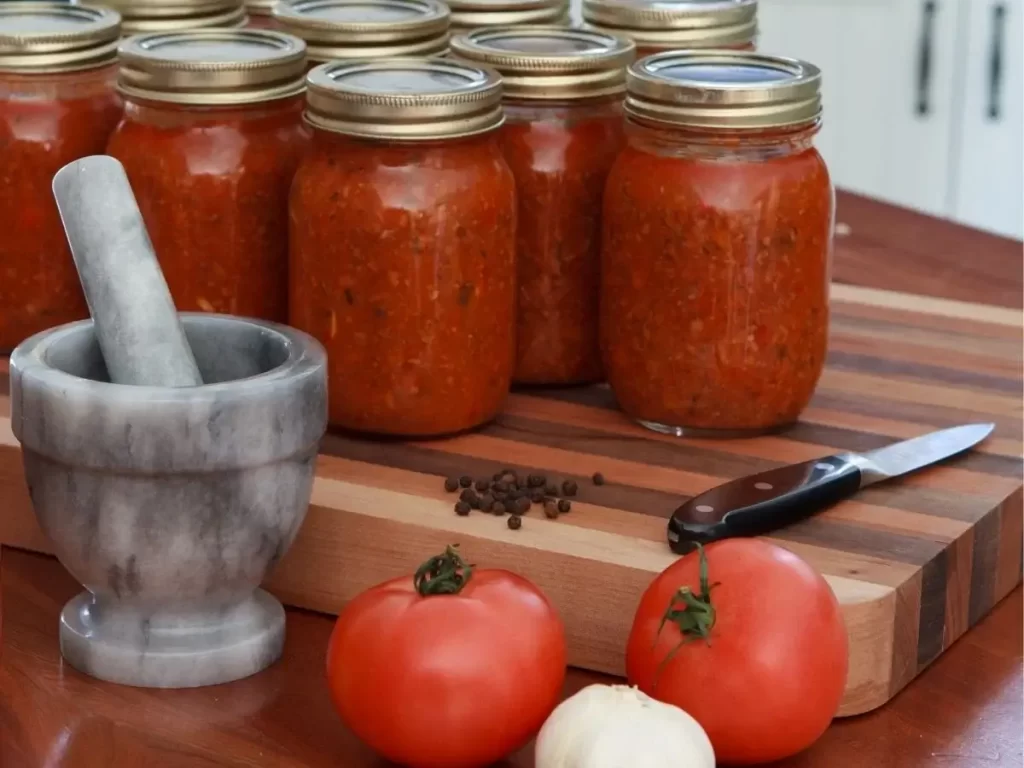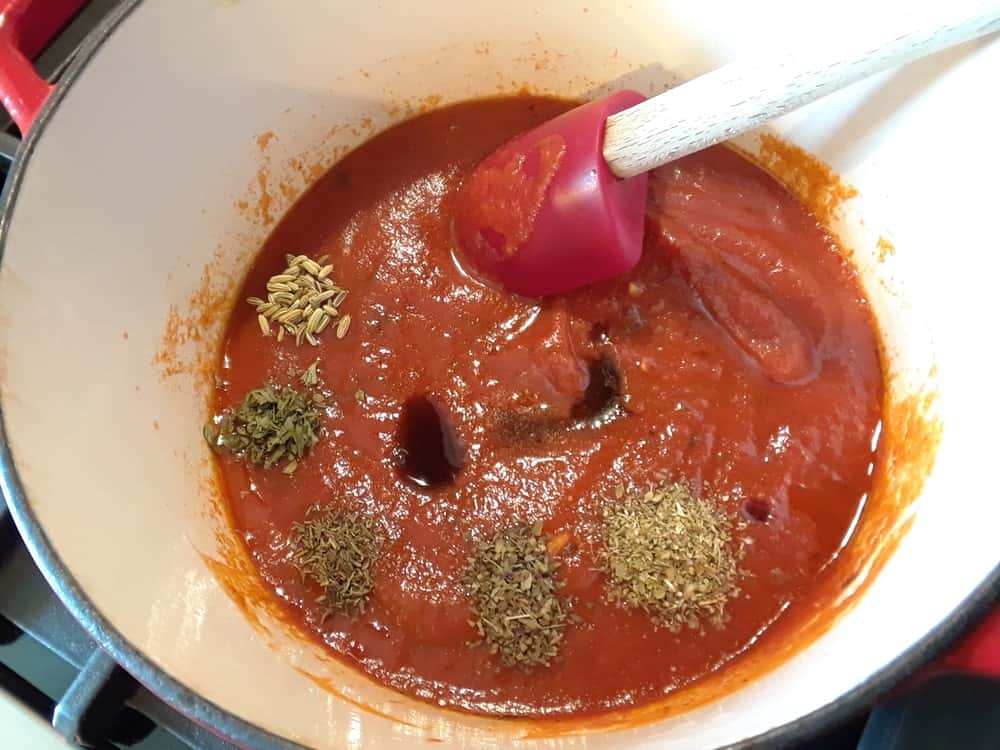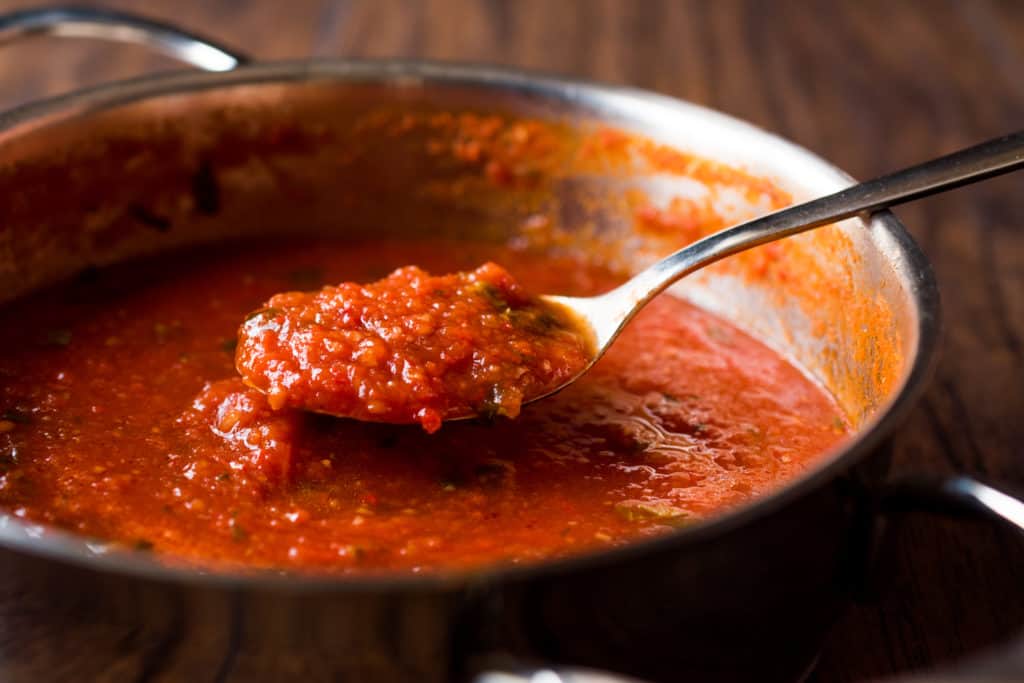
Tomato sauce is a staple in many recipes. Its sweet and acidic flavor can be a great addition to your dishes, but sometimes it can be too acidic for some people’s tastes. If you find yourself with tomato sauce that is too tart or sour, there are several ways to make it less acidic without sacrificing the delicious flavor. From adding sugar or honey to using baking soda or cream of tartar, there are plenty of methods available to help balance out the acidity in your tomato sauce and make it more enjoyable for everyone. Read on to learn how you can make your tomato sauces less acidic!
If you’ve ever made homemade tomato sauce, you’ve probably experienced this at least once. You throw your fresh tomatoes in the pan, then add onions, garlic, and some basil. The kitchen fills up with the delicious aroma of marinara that makes your mouth water.
Then you taste it, and your mouth is shocked at the sauce’s sourness. Yuck!
However, there’s good news. All is not lost because there are things you can do to balance out the flavors in the sauce and make it taste less sour.
What makes tomato sauce taste sour?
The answer to this centers around pH levels. Acids have a low pH level (anything below a pH of 7) and taste sour, while bases have a high pH level and taste bitter.
Tomatoes are acidic foods with a pH range of about 4.3 – 4.9. The lower the number, the more acidic the tomato.
To give you some context, lemons (which are more acidic and sour) have a pH level of around 2.0. Conversely, oranges, known to be very acidic, have a pH range of 3.69 – 4.34 and are only slightly more acidic than tomatoes.
Acidity isn’t necessarily bad, and some people love that sour taste. However, if your tomato sauce is so acidic that it makes your face pucker and sucks out the enjoyment of the sauce, you can do some things to remedy it.
Jarred vs. canned vs. fresh tomato sauce

Tomato sauce is tomato sauce, right? Wrong!
From-scratch tomato sauce will always taste the best because it’s fresh. There is a difference, and it is noticeable.
However, only some people have the time or desire to cook from scratch. If you want to use something pre-made, choose a good-quality jarred sauce brand such as:
- Rao’s
- Barilla
- Classico
- La San Marzano.
Canned tomato sauce tastes acidic and often has a tin flavor that turns many people off. If you want to save time, choose a jarred sauce and use the recommendations below to reduce acidity.
How to make tomato sauce less acidic

There are three primary ways to make tomato sauce taste less acidic: use high-quality tomatoes in your sauce, cook the sauce down, and add things to the sauce to balance out the flavors or raise the acidity level.
Choose high-quality tomatoes
Since tomatoes are the main ingredient in tomato sauce, the type of tomato you use makes a huge difference in the quality of your sauce. So if you want to cut the acidity in tomato sauce, use the best tomatoes.
This applies to both homemade sauces and jarred tomato sauce. Some companies use whatever tomatoes are available rather than adhering to quality standards, so pick a high-quality commercial tomato sauce brand.
All tomatoes are acidic, but they fall within a range on a pH scale based on the tomato variety. Tomatoes with a lower number (closer to 4.3) on the scale are more acidic, while the opposite is true for tomatoes with an acidity level closer to 4.9.
Another thing to consider is the sugar level in tomatoes. This can also vary, and sugar balances out the tart taste of the acid (although it doesn’t change the acidity level). Varieties containing more sugar may taste less acidic when the sugar balances out the sour flavor.
Best ideal tomato varieties to use
Technically, you can use any tomato to make tomato sauce. However, if you genuinely want to make your sauce less acidic, opt for using plum (a.k.a. paste) varieties such as
- Roma
- San Marzano
- Cherry tomatoes
They usually have more flesh with fewer seeds.
Other delicious options include vine-ripened beefsteak or heirlooms.
It may be challenging to tell on jarred tomato sauce what type of tomatoes they use, but occasionally you will see plum or Roma tomatoes listed on the label.
Cook with fresh tomatoes
If you want a less acidic tomato sauce, make it with fresh tomatoes instead of canned ones because the canning process increases acidity!
Choose ripe fruits
As tomatoes ripen, they lose some of their acidity. Check their ripeness by holding and gently squeezing each one individually. You want to use heavier and softer (not mushy) tomatoes.
Consider cooking non-red varieties
If cutting acidity is about more than simply making a great-tasting tomato sauce (ex: preventing heartburn), try using yellow varieties such as:
- Yellow Pear
- Georgia Steak
- Big Rainbow
Alternatively, mix a few of these with your red types to cut the acidity level.
Adjust cooking time
Besides using high-qualities tomatoes, time is your best friend for cutting acidity in tomato sauce.
As tomatoes cook, they become sweeter! Cooking longer doesn’t change the acidity level much, but the natural sugars become more concentrated as water evaporates. The higher sugar content makes the sauce taste less acidic and more flavorful.
Sugar balances out acidity, so if your sauce tastes sour, try simmering it for another 10-15 minutes to sweeten your sauce without having to add sugar.
Enhance the sauce with additional ingredients
If you’re cooking with acidic tomatoes and cooking down the sauce isn’t making enough of a difference, you can add things to the sauce to round out the flavors and make it seem less acidic.
Note: Some of these ideas will change the acidity level, while others only impact the taste. This list includes them all because the perception of acidity matters.
Vegetables
Onions are naturally acidic, but they’re less acidic than tomatoes. Plus, they taste really good in tomato sauce! When you caramelize them, they become slightly more alkaline as the sulfur levels decrease during cooking.
Garlic is alkaline and adds incredible flavor. Mince it and saute it briefly or add it to the sauce near the beginning of cooking.
Carrots are another great vegetable to add to tomato sauce because their natural sweetness helps balance the flavors.
Mushrooms are naturally alkaline, taste delicious in tomato sauce, and will cut the acidity.
Leafy greens such as spinach and kale are also naturally alkaline and right at home in tomato sauce. They cook down well, but you can always chop them roughly to blend them into the sauce more.
Sugar
Adding sugar is a tried and true method for making tomato sauce less acidic. A half teaspoon of sugar won’t necessarily change the acidity level of the sauce, but it will balance out the flavors and make it taste less acidic.
Note: Make sure to taste your sauce after adding sugar and let it simmer for a few minutes to ensure you don’t need to add any more.
Like salt, a little bit of sugar can act as a flavor enhancer and draw out the natural sweetness of the tomatoes without making the sauce taste sugary.
If you don’t have sugar (or want to use a less-processed sweetener), opt for honey or agave nectar but skip the brown sugar or maple syrup because they alter the primary flavor of the sauce too much.
Fatty dairy products
Another way to make tomato sauce less acidic is to add fat to reduce the sour taste!
A teaspoon of butter, some crumbled cheese, or a heavy cream splash to help balance the acidity.
Note: Avoid adding cream if you want a simple (not creamy) tomato sauce.
Cheeses such as parmesan, mozzarella, mascarpone, and ricotta are commonly-used Italian cheeses that work well with tomato sauce. You won’t need to use a lot at a time because you don’t want it to overpower the dish and detract from the tomato taste.
One of the best techniques is to saute some onions, garlic, and mushrooms in butter. Then add them to your tomato sauce and let it simmer for 5-10 minutes to let the flavors marry together.
Herbs
Green herbs such as basil, parsley, rosemary, and oregano are alkaline and add delicious, well-rounded flavor to tomato sauce while cutting acidity.
Fresh herbs can turn bitter with heat exposure, so add them at the end of cooking. However, dried herbs can cook longer because they need to rehydrate to benefit from their full flavor potential.
Olive oil
Olive oil isn’t water-soluble, so it has no pH level. However, its richness adds body to the sauce that counteracts the acidity.
You can saute your vegetables in olive oil instead of butter. You can add olive oil at the end of cooking if your sauce still tastes sour.
Baking soda
If you want to change your tomato sauce’s pH level (rather than just the flavor) to make it less acidic, try adding baking soda! It’s a powerful alkaline that can counteract the acidity in your sauce without adding sugar.
Use a minimal amount (about a ⅛ teaspoon) to make the sauce less acidic without tasting flat. Excellent tomato sauce should contain depth in the flavor.
Note: You will see the baking soda fizz when you add it to the sauce as it reacts to the acid. It won’t last long.
Some people use this method as their go-to, but it can make the tomato sauce less acidic – and flat-tasting because it doesn’t offer any flavor balance. So, for example, you may find that adding sugar creates a more balanced-tasting sauce than you get when adding baking soda.
FAQs

Here are a few common questions that people frequently ask about cutting the acidity in tomato sauce.
Does butter reduce acidity in tomato sauce?
Since butter is fat-based, add it to the sauce and let it meld in. It might sound odd to anyone who’s never tried it, but it will balance the acidity and make your sauce taste rich.
Does putting a carrot in tomato sauce reduce acidity?
Adding carrots to your tomato sauce adds a subtle sweetness, which reduces the perception (or taste) of acidity. Simply dice up a carrot, put it in the sauce, and let it simmer to soften and blend its flavor with the sauce.
Are canned tomatoes more acidic than fresh tomatoes?
Yes! The canning process adds acidity. Simply using fresh tomatoes over canned tomatoes will reduce your sauce’s acid level. However, if that’s not possible, use the other tips to balance out the pH or flavors.
How do you sweeten tomato sauce without sugar?
If you want to reduce that sour taste without adding sugar, try these options. You can cut the acidity in tomato sauce without baking soda by sauteing onions, garlic, carrots, and mushrooms in olive oil or butter to draw out their natural sugars and then adding them to your sauce.
Alternatively, add a dash of baking soda to balance the pH level and make the sauce taste sweeter.
Since tomatoes are the base of tomato sauce, their acidity creates a sauce that can sometimes taste too sour. So whether you make sauce from scratch using fresh tomatoes or open a jar (or can) of tomato sauce, try the suggestions above to make your tomato sauce less acidic to taste balanced and flavorful.
